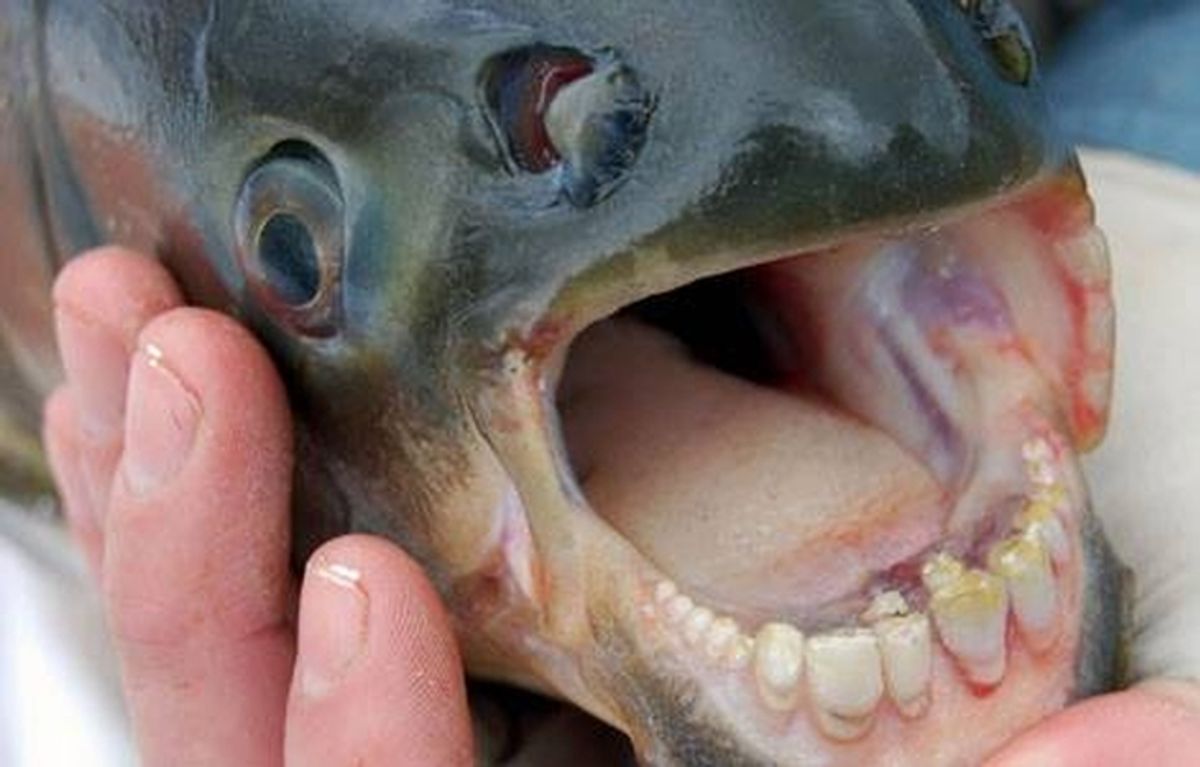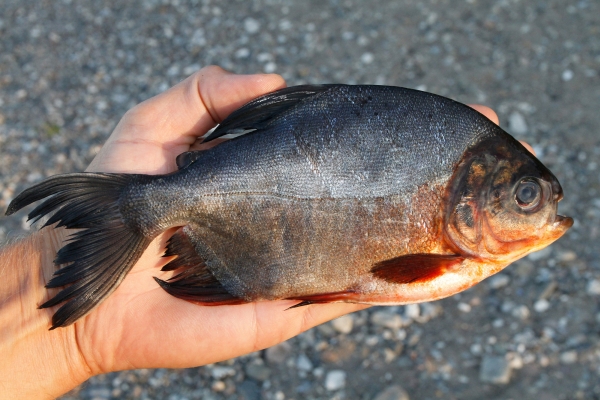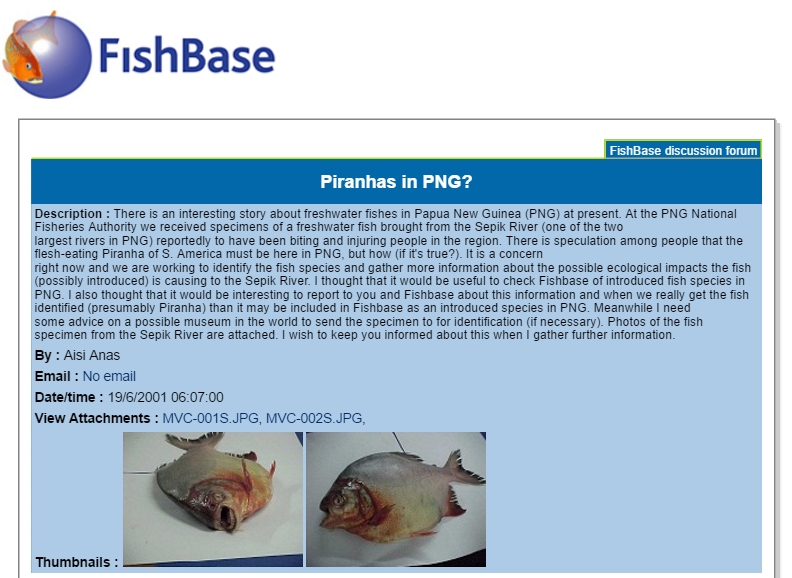The pacu is a cousin of the piranha with human-like teeth, and in 2001, one male swimmer was reportedly bitten on the genitals and a female swimmer bitten on the leg by pacu fish in in Papua New Guinea (both victims survived).
There are no documented instances of Pacu fish biting men's testicles off, or of anyone's dying from a pacu bite.
Origin
It's probably safe to say that most people had never heard of the red-bellied pacu before press reports came out in 2013 warning Scandinavian men not to swim nude in the strait of Oresund (a body of water between Denmark and Sweden) at the risk of losing their testicles to a "fish with human teeth." The lurid warnings weren't just published in northern Europe, but all over the world:
Reputed Testicle-Eating Fish with Human-Like Teeth Caught in Michigan
Wildlife officials aren’t as worried about men’s testicles as they are how the tropical fish ended up in Lake St. Clair to begin with.
Pacus earned their nasty reputation for feasting on male genitalia after Animal Planet host Jeremy Wade featured them on “River Monsters” in 2011. The story of two Amazonian fishermen who died after their testicles were bitten off by pacus went wild on the internet.
The legend grew when the pacu reportedly showed up in Denmark three years ago, leading a fish expert at Denmark’s University of Copenhagen to warn male swimmers against skinny dipping in the Baltic waters. And in Papua New Guinea in the southwestern Pacific, the invasive species is blamed for castrating a couple of local fishermen.
"If you’re going swimming in Scandinavia," began a Huffington Post article dated 11 August 2013, for example, "wear your trunks — no ifs, ands or nuts":
Authorities are warning skinny dippers about the Pacu, a fish similar to the piranha that really enjoys cracking nuts with its strong jaws. They’ve also been known to mistake testicles for something nice and crunchy, and they’re strong enough to take off a finger.
Fisherman discovered the horrifying little creature, which is native to South America, in the Danish/Swedish strait of Oresund, CNN reports. The Pacu can grow to 55 pounds, has giant teeth and looks angry, but is usually the more friendly cousin of the piranha. That is, until it sees a testicle.
This was the sort of fluff readers might have just chuckled at and ignored, except that in most cases it bore the imprimatur of experts — biologist Henrik Carl of the Natural History Museum of Denmark, for one, who was quoted on the Swedish news site The Local:
"The pacu is not normally dangerous to people but it has quite a serious bite, there have been incidents in other countries, such as Papua New Guinea where some men have had their testicles bitten off," said Henrik Carl, fish expert at the Danish museum.
While Carl said the museum's warning about the pacu, sometimes known as the "ball cutter", was meant "as a bit of fun", human victims of the pacu are rarely laughing.
"They bite because they're hungry, and testicles sit nicely in their mouth," he explained.
Well, that scared some people — so much so that museum associate professor Peter Rask Møller, who had written the tongue-in-cheek press release that started it all in the first place, issued a second statement saying it was all just kinda-sorta a joke:
We did say that we recommend men to keep their swimsuits tied up until we know if there are more pacus out there in our waters. Of course, this is half a joke since it is very unlikely that you would actually meet one here and that it would bite you. It's up to people themselves how careful they want to be. I'll keep my shorts on, though.
It only got more confusing from there. Were the fish really dangerous, or not? Had they attacked people, or not? A zoologist consulted by CNN said definitely not:
William Fink, a piranha researcher at the University of Michigan who is also curator of fishes at the school's Museum of Zoology, poured water on the pacu warning. For one thing, he said, pacus are vegetarian — and there's no record of them attacking a human.
"They're fruit eaters. Those big crushing teeth they have is for crushing seeds," he said.
Pacus tend to swim under fruiting trees during high water, waiting for the trees to drop their fruit, seeds and nuts, Fink said. The fish then swim to the surface to eat the tasty morsels.
In fact, Fink said, that's how fishermen catch them: by putting a piece of fruit on the end of a line and letting it float in the water. Pacus swim up to grab it and then get caught.
"The nuts that they're eating, the fruits that they're eating, are splashing down from above, and humans don't act like that when they're swimming," Fink said.
And unlike piranhas, which have rigid, razor-sharp interlocking teeth, pacus have teeth that resemble human molars and fit together in a similar bite, Fink said. The pacus use those teeth to crush their food, not to rip it apart — or off.
Which would seem cut-and-dried enough to quell all controversy, and in some quarters it did. The CNN article quoting Fink is still cited as evidence in a Wikipedia entry stating that the pacu testicle biting claims were "incorrect" and "based on a joke that was not meant to be taken seriously."
But, in fact, they weren't based on a joke. Rumors about pacu biting men's testicles had already been circulating for years when Peter Rask Møller incorporated them into his 2013 press release. They had cropped up most recently during the 2011 season of the Discovery Channel TV show River Monsters, hosted by daredevil fisherman Jeremy Wade:
https://youtu.be/-_bkNDh-4Aw
"I had heard of a couple of fishermen in Papua New Guinea who had been castrated by something in the water," Wade told the Daily Mail in December 2011. "The bleeding was so severe that they died. The locals told me that this thing was like a human in the water, biting at the testicles of fishermen. They didn’t know what it was."
Wade was eventually able to track down one of the alleged victims of these alleged attacks, but in the beginning, he had difficulty finding people who had first-hand knowledge of a pacu attack. Even for the locals, including those living on the Sepik river where the mutilations were said to have occurred, it was just a story they had heard and repeated ad infinitum.
At that point, the story was a decade old.
Piranhas?
The earliest piece of evidence we find hinting at possible pacu attacks in Papua New Guinea was a 19 June 2001 query on FishBase, an online forum used by ichthyologists to exchange information:
The query cites speculation that a fish reported to have bitten and injured people in the Sepik River might be a flesh-eating piranha:
At the PNG National Fisheries Authority we received specimens of a freshwater fish brought from the Sepik River (one of the two largest rivers in PNG) reportedly to have been biting and injuring people in the region. There is speculation among people that the flesh-eating Piranha of S. America must be here in PNG, but how (if it's true?). It is a concern right now and we are working to identify the fish species and gather more information about the possible ecological impacts the fish (possibly introduced) is causing to the Sepik River.
A month later, however, the National Fisheries Authority employee posted again, stating that the species had been identified as Piaractus brachypomus — the red-bellied pacu. But note what else he said about the Sepik River biting incidents:
Our scientific team just came back from the Sepik and Ramu rivers. It was difficult to bring specimens of the fish to Port Moresby so I am not able to send any to the museums we suggested earlier. Augustine Mobiha (the fisheries scientist involved) had collected enough morphometric data which helped us identify the fish as Pacu ( Piaractus brachypomus) and not Piranha. We also found out that the reports of people been [sic] bitten and 3 people killed by the fish were not true.
So, within a month after fatal fish biting incidents were reported on the Sepik River, officials of the Papua New Guinea National Fisheries Authority investigated the reports and determined that, while there were pacu in the river, they hadn't attacked and killed anybody. Which might have been the end of the story had not the press gotten ahold of it.
'Two die in fish dismemberment'
Approximately two weeks before fisheries officials came back with the results of their investigation, the Australian Associated Press (AAP) got wind of the pacu attack story and ran with it:
Two Papua New Guinea fishermen have bled to death after having their penises bitten off by piranha-like river fish.
The fish, which zero in on urine streams in the water, have struck terror among villagers along the Sepik River, in north-western PNG.
Authorities believe the killer fish is an introduced member of the South American pacu family and a relative of the piranha.
In both of last month's fatalities, the fish demonstrated a trait of the piranha by following a trail of urine in the water, swimming to its source and then biting it off with razor-sharp teeth.
Since when did following a trail of urine become a "demonstrated trait of the piranha"? We don't know. In the past, such a trait has been attributed to a tiny parasitic fish called the candiru, but even then not without controversy.
While acknowledging that the specific claim here is that one or more pacu fish killed two men in Papua New Guinea by biting off their penises, not testicles, we're fairly certain that this story — which is itself clearly based on little more than contemporaneous rumors — was the wellspring of all later mentions of genital-biting pacu fish in the media.
The official report
Albeit largely (though not entirely) ignored by those same media, the National Fisheries Authority went public with the results of its pacu investigation in their July 2001 newsletter:
With regards to local newspaper reports that people are being killed by the Pacu Fish, the investigation has revealed the following;
1. Within the area between Korogu village and along the Sepik River to Wagu village (up river from Ambunti Government Station) only one person was attacked on his private part. This person required medical treatment and came from Korogu village. A lady also claimed to have been bitten by the Pacu on her legs, just above her knees. She had some scars present.
2. No deaths from the introduced Pacu Fish attacks were reported from Korogu to Wagu villages.
A passage from the actual report written by National Fisheries Authority investigator Augustine Mobiha offers somewhat more detail:
There were reported to be two people killed in the Sepik River area by the local media. My investigations through talking with local people in the villagers within the Wagu village to Ambunti station to Korogu villages have indicated that no people were killed.
The investigations revealed that four people in Korogu village were reportedly attacked by fish. One of the four individuals was bitten in the private parts area of his body and required professional medical attention.
Two of the four individuals were in the river doing their toilet and were frightened by a fish but were not bitten. One lady claims she was bitten by the Pacu fish and has scars on her knee which she claims was from the bites.
All the fisheries officers from Angorom to Ambunti along the Sepik River report no deaths due to attacks by the Pacu fish. No individuals from areas between Angorom and Korogu were interviewed but it is anticipated that any deaths due to attack by the Pacu fish would be news and would be known by all officers working in the area.
The rest, dear readers, is folklore.



